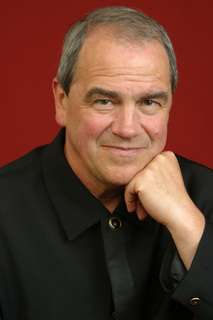|
Back
Studies in Contrast Houston
Jones Hall
03/05/2010 - & Mar. 6, 7
Wolfgang Amadč Mozart: Kyrie, K. 341 – Requiem, K. 626
Béla Bartók: Music for Strings, Percussion and Celesta, Sz. 106
Katherine Whyte (soprano), Paula Rasmussen (mezzo-soprano), James Taylor (tenor), Jason Grant (bass-baritone)
Houston Symphony Chorus, Charles Hausmann (director), Houston Symphony Orchestra, Hans Graf (conductor)

H. Graf (© Christian Steiner)
The Houston Symphony's current repertoire is a revelatory juxtaposition of two contrasting masterworks that exemplifies the glorious thread that runs through the history of Western music. Late in both their careers, Mozart and Bartók conflated their extremely personal rhetoric with Baroque models, and both infused their final works with motivic manipulations and fugal writing that come directly down the timeline from J.S. Bach. Hans Graf's programming of Béla's Music for Strings, Percussion and Celesta alongside Wolfgang's Requiem was a stroke of genius, and he was joined by his orchestra and vocalists in an intense, moving night of music-making.
The performance of the Bartók was for the most part subdued, Graf emphasizing the eerie nocturnal qualities of the music and softening some of the work's sharper edges. The first movement fugue, that epitomic essay of compositional control, was delivered with steely precision. The climax might not have been as fiercely shattering as in some performances, but in relation to the whispers of the beginning and ending of the movement, it was a summit of string tone. The second movement benefitted from a slightly measured tempo, allowing the audience to appreciate the exciting, folk-influenced cross-rhythms and Graf to generate a rousing increase in tempo for the piano's syncopated theme later in the movement. This energy was furthered in a breakneck coda played with exhilarating accuracy by the orchestra. The acoustics in Jones Hall were surprisingly flattering to this work, and Bartók's expertly judged polyphonic writing was readily apparent.
The third movement is indelibly linked to fantasy and horror vis-ŕ-vis Hollywood, but Graf let the music speak for itself. He guided every glissando, pizzicato and ponticello tremolo with unfaltering clarity into a beautiful, balanced reading of a movement that can often be overly sensational. The proceedings were interrupted by a gentleman in the middle of the second row not-too-subtly leaving the hall 30 seconds before the end of the movement. Graf waited patiently for the rogue to depart, but the spell had been broken. The finale was played well enough, but the numerous gear shifts, so effortlessly negotiated in the first three movements, became jerky and, for the first time in the concert, slight imperfections in ensemble were noticeable. One hopes that nothing interrupts the performers' focus in the remaining two nights of this program.
The Mozart Requiem was given a bold, venomous reading. Graf let the Houston Symphony Chorus sing with abandon, and the impact was quite impressive. The Kyrie and Dies Irae were brisk and precise, the Recordare wonderfully tender, and the Lacrimosa a study in perfectly tiered phrasing. The quartet of soloists was uneven in solo passages. Tenor James Taylor stood out for his intelligent phrasing and pure, focused tone that projected easily over the orchestra, and mezzo Paula Rasmussen was his equal in her less frequent contributions. Soprano Katherine Whyte and bass-baritone Jason Grant have lovely voices, but it was difficult to hear their voices over the orchestra, an issue that abated as the performance progressed. When singing as a unit, however, the soloists matched the balance and tonal blend of the chorus, and their interplay in the Benedictus was a highlight of the performance. The flagging inspiration of the work after the Sequenz is always a slight disappointment, but it emphasizes the glory of the opening eight sections.
The tacking-on of the early, stand-alone Mozart Kyrie was somewhat unfortunate. The piece pales in comparison to the Introitus and Kyrie of the Requiem, and the logistics of a 10-minute shuffling of stage setup after a seven minute choral work got the concert off to an unbalanced start. In a performance as stunningly executed as it was here, the Bartók is substantial and intriguing enough to form the entire first half of a concert. This is a minor complaint, however, and in the end this was the strongest program that Graf has presented with his orchestra this season.
Marcus Karl Maroney
|